Creating a custom window or door
About
In BricsCAD, you can create any geometry or component from scratch. Once you have your geometry in 3D you can insert and use it in your BIM model. You can make changes or add more details to your window or door at any time.
This process is explained in 4 parts to make the steps of creating a 3D window or door geometry straightforward.
-
Create the file
-
Create the subtractor solid (1)
-
Create the window or door frame (2)
-
Create the (Glass) panes (3)
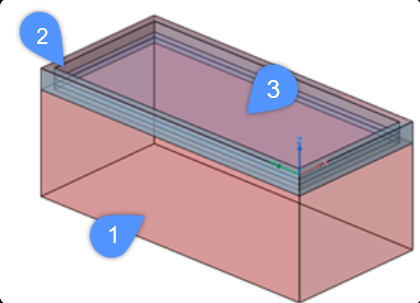
Creating a custom window
- Click New in the File menu.
- Select one of the pre-defined templates to create a simple window specifying the unit system of your drawing.Note: The pre-defined templates contain the layers needed to create the geometry of the window or door. These DWT file format templates are BIM-Window-imperial (4) and BIM-Window-metric (5) which assure the required layers and properties are displayed in your drawing.

- Set the BC_SUBTRACT layer current (6) either using the drawing explorer or layer field in the Properties panel or Layers panel on the right-hand side.
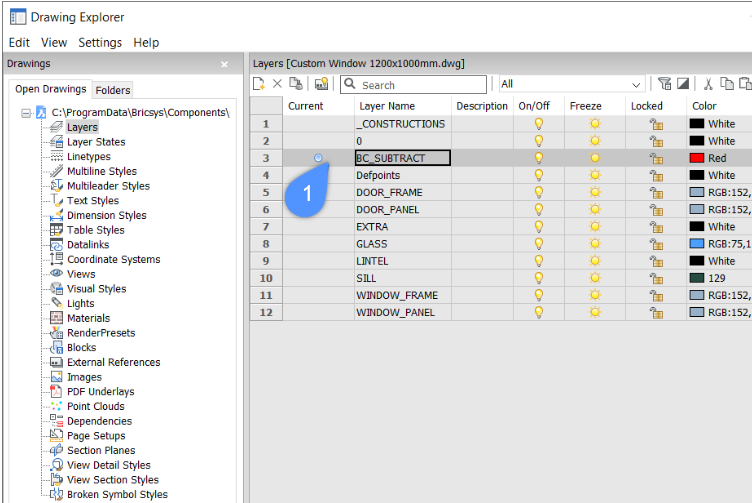
- Create a closed polyline (e.g. a rectangle) that represents the form of the opening for the insert.
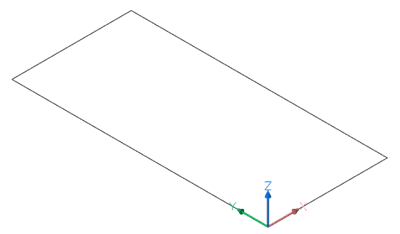
- Save the file in any location. The library of user defined components is located in the Components folder. The folder's path is stored by the COMPONENTSPATH system variable.
By default this is: C:\ProgramData\Bricsys\Components. You can add more folders using the Settings dialog box.
Note: The library of predefined components can be found under C:\Program Files\Bricsys\BricsCAD en_US\UserDataCache\Support\en_US\Bim\Components.
Step 2: Creating the subtractor solid
The subtractor solid will be used to create an opening.
- Use the outline of the solid which you have previously created (e.g. a rectangle).
The outline lies in the first quadrant of the XY plane of the World Coordinate System (WCS).
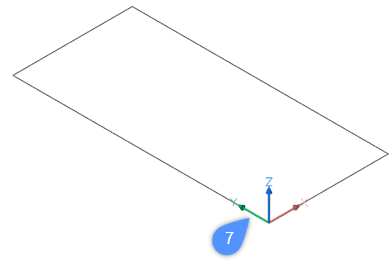
The lower left corner of the rectangle lies at the origin (0,0,0) of the WCS (7).
- Select the Extrude tool and move the cursor downward (8) to extrude your solid outline in the negative Z direction.

- Do one of the following to finish the subtractor solid creation.
- Click a point.
- Type a value in the dynamic dimension fields, then press Enter.
Note: Make sure that the height of the extrusion is greater than the width of the wall the component will be inserted into.
Step 3: Creating the fixed frame
The outline of the fixed frame coincides or is parallel (in case of a rebate) with the outline of the subtractor solid.
- Set the WINDOW_FRAME layer current.
- Highlight the top face of the subtractor solid.
- Next, extrude the top face of the subtractor solid in the negative Z direction (9) using the Extrude tool ‘Create’ (10) option by pressing the Ctrl key once.

- Type a value in the dynamic dimension field to specify the height of the fixed frame.Note: The height of the extrusion will be the thickness of the fixed frame.
- Turn off the BC_SUBTRACT layer by clicking the light bulb (11) next to the layer name.
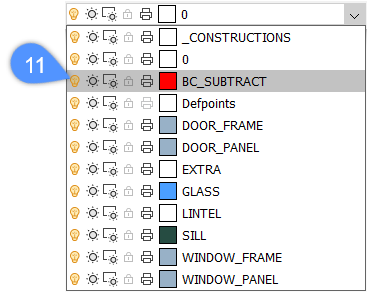
- Use the Offset tool to create a parallel offset of the outline of the fixed frame (12).

Note: The distance of the offset equals the width of the frame. - Hover over the inside boundary of the parallel offset (13) and select Extrude tool from the Quad.
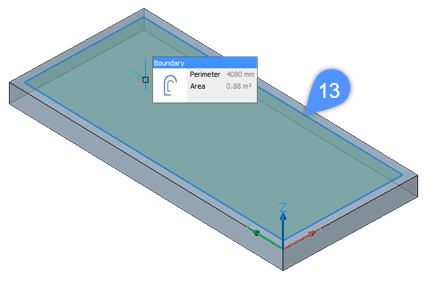
- When the extrude mode is on the Subtract option (14) move your cursor downward (15) to create an opening in the fixed frame.
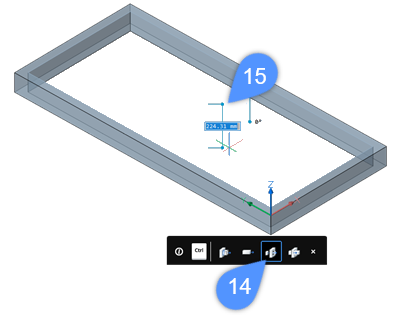
- Do one of the following to finish the creation of the opening in the fixed frame.
- Click a point.
- Type a value in the dynamic dimension fields, then press Enter.
- Set the GLASS layer current.
- Use the DMEXTRUDE command to extrude the inside boundary of the window frame.Note: The height of the extrusion equals the thickness of the glass pane. The following illustration shows the inside boundary of the window frame after using DMEXTRUDE command to create a window glass pane.
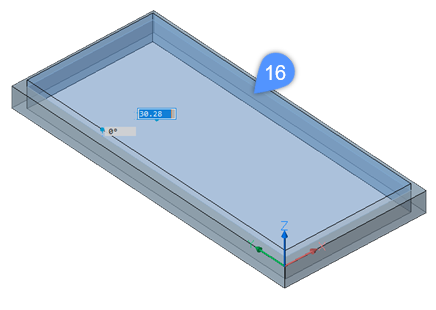
Note: To create a glass pane, the Create option should be selected from the Tooltip of DMExtrude. - Move the glass pane solid down in the negative Z-direction if the outside face of the fixed frame does not coincide with the outside face of the solid (wall) the insert will be placed in.
The following illustrations show the glass pane solid after moving it (17) down.

- Optionally, before saving the drawing, you can classify the entire drawing as a BIM window element.
To do so, follow these steps:
-
Type BIMCLASSIFY in the Command line.
-
Press 'I' for window and press Enter to accept it.
-
Next, press 'D' for Drawing and press the Enter key until the command is executed.
The drawing is now classified as a window. Thus, it will automatically be recognized as a BIM Window element when inserted into a new drawing.
-
- Save the drawing.
- Optionally, you can assign more information to the window after inserting it into a new drawing. The following illustration shows the Window Common category of BIM properties from the Properties panel that becomes available after selecting the element. Information can be assigned about the thermal transmittance coefficient of the window materials, fire rating according to the national fire safety classification, and so on.
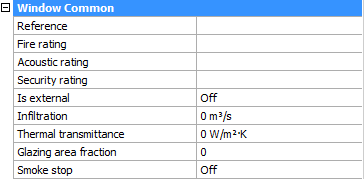
Adding 2D entities (door swing)
Optionally, windows and doors drawings can contain 2D symbols. These 2D symbols will either replace the actual 3D Solid section of the window or door or be added to the 3D Solid section, depending on their layer:
- Symbols on a layer with prefix “BRX_2D_” or “ BRX_2D+_” will be added to the section block:
- without being processed by analytical hidden line removal (HLR) when the section plane intersects the components.
- after going through analytical hidden line removal (HLR) procedure when the section plane does not intersect the components.
- Symbols on a layer with prefix “BIM_2D_SECT_“ or “BIM_2D_SECT+_ “ will be added only when the section plane intersects the components. All geometry goes through analytical hidden line removal (HLR) procedure.
- Symbols on a layer with prefix “BIM_2D_BACK_” or “BIM_2D_BACK+_” always will be added and all geometry goes through analytical hidden line removal (HLR) procedure.
- Symbols layers name
- with “+”: both the 2D symbol and the 3D solid section of the component are shown in the section result.
- without the “+” only the 2d content is shown and all solids in the component are ignored for section generation.
To add a 2D symbol to your component follow the next steps:
- Add a new layer ‘BRX_2D+_*’ and set it as the active layer. The 2D geometry added to this layer will be visible when you cut a section through this component and generate the section onto a sheet. The cut-through representation of the 3D geometry in the component will be visible as well.
- Before starting drawing the 2D symbol of the component, make sure the Z axys is perpendicular to the bottom plane of the component and pointing upwards. You can do this either by switching your UCS (using UCS command, rotating it 90 degrees over the X-axis) or by enabling the Dynamic UCS (DUCS) feature.
- Switch your view to the Top view by using the Look From widget.
- Start drawing the 2D geometry on the ‘BRX_2D+_*’ layer.Note: Use only Polyline entities, as these will be recognized when generating the component's section (while the Line entities will not be recognized).
- Switch back to a 3D view of your model and check that the following are visible:
- the solids on the BC_SUBTRACT layer
- the component's solids
- the newly drawn 2D geometry
Parametrizing your component
You can do this first for the 3D geometry and then for the 2D geometry.
- Select all 3D geometry of your component, including the geometry under the BC_SUBTRACT layer (make sure this layer is turned On first).
- Run the PARAMETRIZE command for the selected geometry and check the contraints that appear in the Mechanical Browser panel.
- Optionally, you can rename the parameters as needed (for example, you can rename the 'Length_X' user parameter as 'Width', etc.). You can also change some of the constraints and parametric behavior previously defined.
- Use the UCS command to change the UCS so that the 2D geometry lies in the XY-plane of the UCS.
- Select the 2D geometry previously added to your component.
- Run the PARAMETRIZE2D command for the selected geometry and check the contraints that appear in the Mechanical Browser panel.
- Repeat step 3. Make sure to connect the newly created 2D parameter on the X-direction to the 'Width' 3D parameter by typing this 3D parameter's name as the 2D parameter's value.Note: The 2D constraining works differently than the 3D constraining, but you can use the same parameter names to control both 2D and 3D types of constraints together.
- Switch back your UCS by selecting the World option of the UCS command. This will prevent undesired results when inserting the component into another drawing.
- Turn the BC_SUBTRACT layer Off.
- Save the drawing.
- Insert the component into your model from the Library panel or by using the BMINSERT command. With the component selected, change the parameters from the Properties panel to check that everything behaves as expected.

